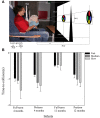Development of Visual Motion Perception for Prospective Control: Brain and Behavioral Studies in Infants
- PMID: 26903908
- PMCID: PMC4746292
- DOI: 10.3389/fpsyg.2016.00100
Development of Visual Motion Perception for Prospective Control: Brain and Behavioral Studies in Infants
Abstract
During infancy, smart perceptual mechanisms develop allowing infants to judge time-space motion dynamics more efficiently with age and locomotor experience. This emerging capacity may be vital to enable preparedness for upcoming events and to be able to navigate in a changing environment. Little is known about brain changes that support the development of prospective control and about processes, such as preterm birth, that may compromise it. As a function of perception of visual motion, this paper will describe behavioral and brain studies with young infants investigating the development of visual perception for prospective control. By means of the three visual motion paradigms of occlusion, looming, and optic flow, our research shows the importance of including behavioral data when studying the neural correlates of prospective control.
Keywords: brain and behavioral development; optic flow processing; perceptual information for action; prospective control; visual motion perception.
Figures




Similar articles
-
Longitudinal study of preterm and full-term infants: High-density EEG analyses of cortical activity in response to visual motion.Neuropsychologia. 2016 Apr;84:89-104. doi: 10.1016/j.neuropsychologia.2016.02.001. Epub 2016 Feb 4. Neuropsychologia. 2016. PMID: 26852826
-
Longitudinal study of infants receiving extra motor stimulation, full-term control infants, and infants born preterm: High-density EEG analyses of cortical activity in response to visual motion.Dev Psychobiol. 2022 Jul;64(5):e22276. doi: 10.1002/dev.22276. Dev Psychobiol. 2022. PMID: 35603414 Free PMC article.
-
Looming responses of telencephalic neurons in the pigeon are modulated by optic flow.Brain Res. 2009 Dec 11;1305:40-6. doi: 10.1016/j.brainres.2009.10.008. Epub 2009 Oct 12. Brain Res. 2009. PMID: 19822131
-
Self-motion perception in Parkinson's disease.Eur J Neurosci. 2021 Apr;53(7):2376-2387. doi: 10.1111/ejn.14716. Epub 2020 Mar 20. Eur J Neurosci. 2021. PMID: 32141143 Review.
-
Human cortical areas underlying the perception of optic flow: brain imaging studies.Int Rev Neurobiol. 2000;44:269-92. doi: 10.1016/s0074-7742(08)60746-1. Int Rev Neurobiol. 2000. PMID: 10605650 Review.
Cited by
-
Development of motion speed perception from infancy to early adulthood: a high-density EEG study of simulated forward motion through optic flow.Exp Brain Res. 2021 Oct;239(10):3143-3154. doi: 10.1007/s00221-021-06195-5. Epub 2021 Aug 21. Exp Brain Res. 2021. PMID: 34420060 Free PMC article.
-
Impact of Visual Design Elements and Principles in Human Electroencephalogram Brain Activity Assessed with Spectral Methods and Convolutional Neural Networks.Sensors (Basel). 2021 Jul 9;21(14):4695. doi: 10.3390/s21144695. Sensors (Basel). 2021. PMID: 34300436 Free PMC article.
-
OWLET: An automated, open-source method for infant gaze tracking using smartphone and webcam recordings.Behav Res Methods. 2023 Sep;55(6):3149-3163. doi: 10.3758/s13428-022-01962-w. Epub 2022 Sep 7. Behav Res Methods. 2023. PMID: 36070130 Free PMC article.
-
Hierarchical microstructural tissue growth of the gray and white matter of human visual cortex during the first year of life.bioRxiv [Preprint]. 2025 Jun 22:2025.06.20.660718. doi: 10.1101/2025.06.20.660718. bioRxiv. 2025. PMID: 40666947 Free PMC article. Preprint.
-
Selective attention to real-world objects drives their emotional appraisal.Atten Percept Psychophys. 2021 Jan;83(1):122-132. doi: 10.3758/s13414-020-02177-x. Epub 2020 Oct 30. Atten Percept Psychophys. 2021. PMID: 33128216
References
-
- Agboada D., van der Meer A. L. H., van der Weel F. R. (2015). Infants' cortical responses to audiovisual looming studied with high-density EEG. Cogn. Behav. Psychol. 7, 152–160. 10.5176/2251-1865_cbp15.07 - DOI
LinkOut - more resources
Full Text Sources
Other Literature Sources
Research Materials

